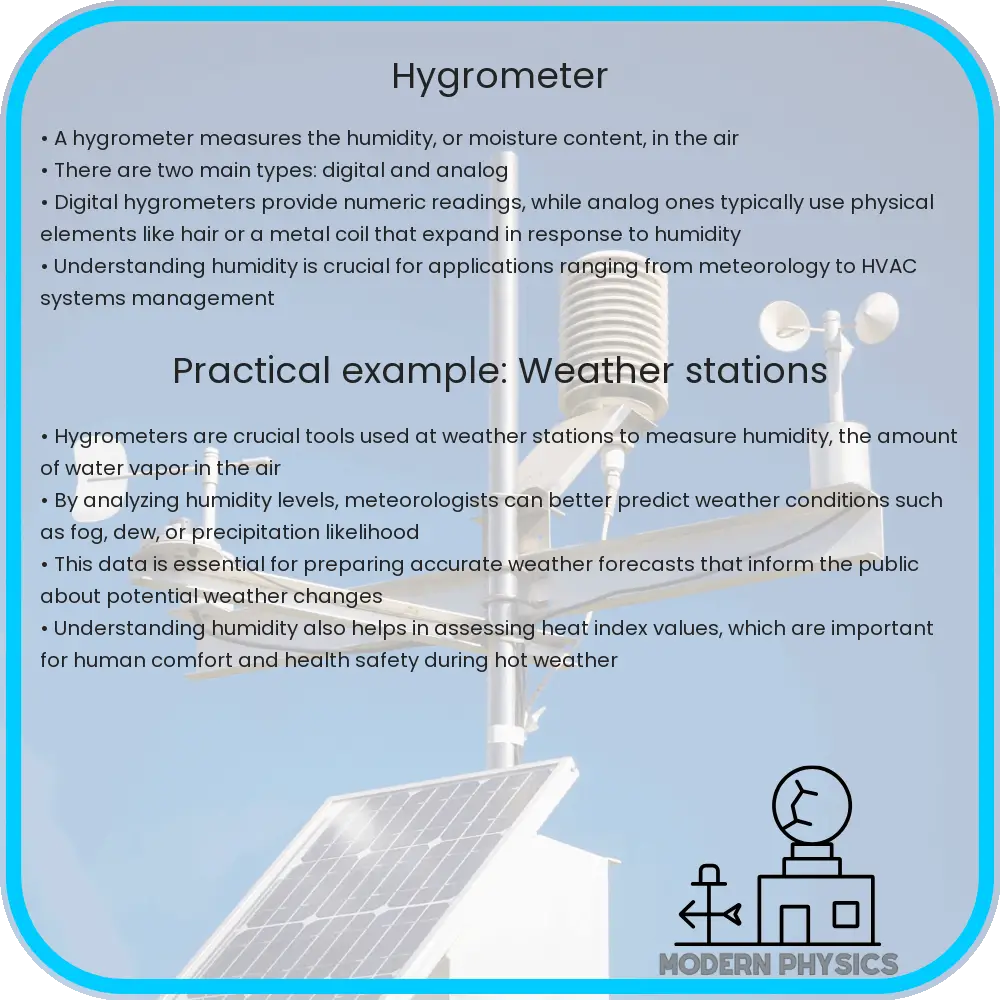Explore the science behind hygrometers, their accuracy, types, and the role of fluid dynamics and chemistry in humidity measurement.

Understanding Hygrometers: Measurement, Accuracy, and Fluid Dynamics
Hygrometers are essential tools for measuring humidity, the amount of water vapor present in the air. They find applications in various fields, including meteorology, HVAC systems, and industrial processes. The accuracy of a hygrometer and its functionality rely heavily on the principles of fluid dynamics and the chemical properties of the substances used in certain types of hygrometers.
Types of Hygrometers and Their Measurement Techniques
There are several types of hygrometers, each utilizing different methods to measure humidity:
- Psychrometers: These use a pair of thermometers, one with a dry bulb and one with a wet bulb. The evaporation from the wet bulb lowers its temperature, and the difference between the two readings is used to calculate relative humidity.
- Electronic Hygrometers: These rely on sensors that change their electrical resistance or capacitance in response to changes in humidity.
- Dew Point Hygrometers: They determine the dew point – the temperature at which air becomes saturated with moisture and dew forms – to calculate humidity.
Accuracy and Calibration
The accuracy of hygrometers is crucial, especially in sensitive environments like laboratories or manufacturing facilities. Calibration, the process of verifying and adjusting the readings of a hygrometer, is essential to maintain its accuracy. Factors affecting a hygrometer’s accuracy include:
- Temperature Variations: Most hygrometers are sensitive to temperature changes, which can affect their readings.
- Age and Wear: Over time, the components of a hygrometer, especially in mechanical types, can wear out or degrade, impacting accuracy.
- Environmental Factors: The presence of contaminants or chemicals in the air can interfere with the sensor’s ability to accurately measure humidity.
The Role of Fluid Dynamics
Understanding fluid dynamics is crucial in designing and operating hygrometers, particularly psychrometers and dew point hygrometers. The behavior of air and water vapor, governed by fluid dynamics, influences how these devices measure humidity. For instance, in a psychrometer, the rate of evaporation from the wet bulb, which is a fluid dynamic process, determines the temperature difference and thus the humidity reading. Similarly, in dew point hygrometers, the formation of dew, a process influenced by air flow and temperature gradients, is essential for accurate measurements.
In conclusion, hygrometers are sophisticated devices whose design and operation are deeply rooted in the principles of fluid dynamics and chemical properties. The type of hygrometer, its calibration, and environmental factors play significant roles in determining its accuracy and reliability.
Chemical Properties in Hygrometer Operation
The operation of certain hygrometers also involves understanding the chemical properties of materials used. For example, the absorbent material in a hair hygrometer, typically human or animal hair, responds to humidity changes by expanding or contracting. This physical change, driven by the hair’s hygroscopic properties, allows for the measurement of relative humidity. Similarly, in some electronic hygrometers, polymers or salts, which absorb or release water molecules depending on the humidity, are used. The chemical interactions at a molecular level within these materials are critical for the accurate sensing of humidity levels.
Advancements in Hygrometer Technology
Recent advancements in hygrometer technology have focused on enhancing accuracy, durability, and usability. Digital hygrometers with improved sensors offer higher precision and the ability to interface with computer systems for data logging and analysis. Miniaturization has also allowed for the development of portable hygrometers, useful in field applications. Innovations in materials science have led to more robust sensors that can withstand harsh environmental conditions without compromising accuracy.
Applications of Hygrometers
Hygrometers are employed in a diverse range of applications:
- Meteorology: For weather forecasting and studying climate patterns.
- Industrial Processes: In industries such as woodworking, paper production, and textiles, where humidity levels can impact product quality.
- Agriculture: For monitoring greenhouse conditions or soil moisture.
- Building Management: In HVAC systems to maintain comfortable and safe indoor environments.
Conclusion
Hygrometers are indispensable instruments in various sectors, owing to their ability to measure and monitor humidity accurately. The efficacy of these devices stems from a deep understanding of fluid dynamics, chemical properties of materials, and technological advancements. As our knowledge in these areas expands, hygrometer technology continues to evolve, offering more precise, durable, and versatile tools. This evolution not only enhances our capability to measure humidity but also significantly impacts numerous fields from meteorology to industrial processes, highlighting the critical role hygrometers play in our understanding and management of the environment.
